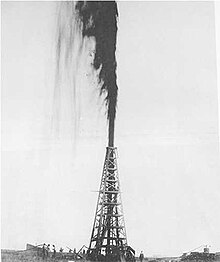Pattillo Higgins
Pattillo Higgins (born December 5, 1863 in Sabine Pass , Texas , † June 5, 1955 San Antonio ) was a Texan entrepreneur in the oil industry. He was considered the prophet of Spindletop , the oil well near Beaumont in Texas, which sparked the Texan oil boom in 1901.
Life
Higgins went to school in Beaumont and then was an apprentice to his father, an armorer. As a teenager, he was considered a troublemaker and was charged on one occasion with shooting an assistant sheriff who tried to persuade him to molest black people. He pleaded self-defense and was acquitted by the jury in the trial. He himself was wounded in the shooting in the arm, which had to be amputated. After that, despite his disability, he worked as a lumberjack on the Texas-Louisiana border. A turning point in his life came in 1885 when, after a Baptist revival meeting, he resolved to lead an honorable life and became a respected Beaumont real estate businessman and then a brick and mortar entrepreneur. He was also religiously active and a Sunday school teacher for girls.
Since he needed fuel for his brickworks and wanted to establish a modern brickworks on Spindletop Hill, a hill raised by a salt dome south of Beaumont, he looked for crude oil, although at the time it was generally believed that it was in the Gulf of Mexico region there was neither oil nor gas. He and his business partner George W. Carroll bought half of Spindletop and teamed up with George Washington O'Brien, who had the concession for the other half and was also convinced of the oil's wealth (you could see oil spilling on the surface). Higgins named the company, founded in 1892, after one of his Sunday school students (Gladys Bingham) Gladys City Oil and Manufacturing Company and became the managing director. Drilling began in 1893 but was unsuccessful. In 1895, Higgins left the company in a dispute that was widely regarded as a failure. The main problems were with the quicksand , which made drilling at greater depths difficult. However, he retained his belief that oil could be found under the hill and advertised nationwide in the United States to find geologists and investors interested in a search. In 1899 he found a supporter in the form of Francis Lucas, an expert in salt domes, who got a concession from Gladys Oil and began drilling, with Higgins having a 10 percent stake. He too was initially unsuccessful, but brought in other financiers from Pittsburgh (including Andrew Mellon ) (who made it a condition, however, that Higgins was left empty-handed in further exploration). In 1900 Lucas got another concession from Gladys City Oil and also from two neighboring farmers, on whose land he finally struck gold on January 10, 1901 (the Lucas Gusher called blowout ). For nine days, an estimated 100,000 barrels of oil flowed every day without the oil being collected and used first.
Higgins then sued Lucas, arguing that his contract with Lucas had not expired at the time of the find. It was finally agreed to pay an undisclosed sum of money. Higgins then founded his own oil company and found what he was looking for on Spindletop with a well that was twice as productive as the original one. In 1902 he sold them for $ 3 million to the timber baron and businessman John Henry Kirby (his real estate involvement limited his liquidity and made him vulnerable to a takeover) and founded a new oil company (Higgins Standard Oil) to help in the following 50 years of drilling for oil in other salt domes on the Gulf Coast. As a businessman he went through ups and downs as he typically sold his sources before they were fully developed looking for new fields again.
Higgins was self-taught in many fields, including geologist, cartographer, inventor, naturalist, designer, and engineer.
He maintained his faithfulness to the Bible all his life, which developed into a puritanical aversion to alcohol and all forms of public entertainment. He was generous to his family. His mother lived with him until her death in 1907. He also regularly adopted orphan girls. In 1908 he married an eighteen-year-old orphan girl (Annie Johns) whom he had adopted in 1905 and with whom he had three children.
literature
- Robert W. McDaniel, Henry C. Dethloff: Pattillo Higgins and the Search for Texas Oil, College Station: Texas A&M University Press, 1989
- Edgar Wesley Owen: Trek of the Oil Finders: A History of Exploration for Petroleum, Tulsa: American Association for Petroleum Geologists, 1975
- Christine Moor Sanders: Captain George Washington O'Brien and the History of the Gladys City Company at Spindletop, Spindletop / Gladys City Boomtown Museum: A Guide and a History, Beaumont: Lamar University, 1992
Web links
- Tracé Etienne-Gray: Pattillo Higgins, Handbook of Texas Online, Texas State Historical Association , accessed May 1, 2015
| personal data | |
|---|---|
| SURNAME | Higgins, Pattillo |
| BRIEF DESCRIPTION | American oil prospector and entrepreneur |
| DATE OF BIRTH | December 5, 1863 |
| PLACE OF BIRTH | Sabine Pass |
| DATE OF DEATH | 5th June 1955 |
| Place of death | San Antonio |
